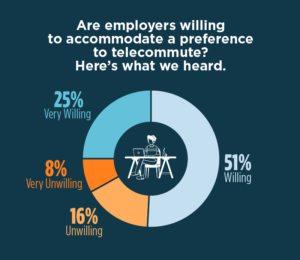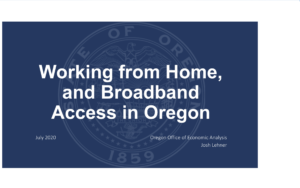
Telework and remote learning have spiked because of COVID-19, raising questions about whether these trends will continue or dissipate after the pandemic passes. Oregon state economists and Kittelson & Associates offer two research-based glimpses into the post-pandemic future.
Kittelson, a national transportation engineering and planning firm, conducted a 40-state, 1,000-commuter survey from May to July in which 60 percent of commuters said they would like to work from home frequently or totally, and 76 percent of their employers are willing or very willing to accommodate them.
The Kittelson survey indicates 66 percent of pre-pandemic commuters drove their cars to work, and 70 percent anticipate driving to work after the pandemic. To the extent there in shift in modes of transportation, Kittelson’s data suggests commuter bus ridership will decline, while walking and biking will increase.
Drawing on previous research, state economist Josh Lehner reports in a blog post that after a spike in working from home due to the pandemic, most workers will likely be recalled to the office when it’s safe. “Permanent massive, wholesale changes to the way we work are unlikely,” Lehner wrote. “That said, even incremental changes and evolutions can matter for regional economies, workforce needs, commercial real estate and the like.”
The state economist says it’s too early to tell whether work-at-home preferences have sparked a flight to the suburbs. But he suggests telework opportunities may work to Oregon’s overall advantage by attracting and retaining talent in the state and diversifying regional economies.
“In essence, these workers are voting with their feet, saying they want to live in our communities,” according to Lehner. “However, it is harder to find a job in their chosen field, so they are making it work by bringing their job with them or starting their own business. This increase in economic diversification should make our regional economies more resilient and better able to withstand different types of recessions over time.”
Kittelson’s survey found employers in the architecture, engineering and planning professions expressing the highest level of willingness to allow remote work. Respondents in the health care industry reported that telework is not an option for them and 43 percent of their employers are unwilling to consider remote work options. Government workers (81 out of 84) and education professionals (71 out of 90) indicated a high level of interest in teleworking occasionally, frequently or full-time.
“Even so,” Kittelson added, “the results to date make clear that significant changes probably will occur in such areas as (a) the trip generation rates associated with certain land uses; (b) the distribution of trip purposes and travel patterns; and (c) the time-of-day distribution profile of traffic volumes.”
The connection between work generally to quality internet access was underlined by state economists. “On the economic side, having residents better connected to labor markets to search for jobs and interact with coworkers and clients is important. It’s not just the availability of a broadband connection, but really it’s about the speed, reliability and price of that connection. Once you get outside major cities in the Willamette Valley, the speed and reliability can fall off, impacting potential growth opportunities.”
On the impact of changing commuter patterns, Kittelson observed, “Commute trips make up only about one fifth of all trips in a given day. So while our survey suggests that there may be reductions in commute trips, the impact to total daily trips is likely to be small. This is because of the combined effects of other factors that might offset the telecommuting findings, including for example a possible decrease in average car occupancy and/or the emergence of latent demand.”
Lehner adds, “Oregon overall does better than much of the country when it comes to broadband access and working from home” with an 88 percent penetration of households compared to 84 percent nationwide. Like the rest of the nation, he says Oregon faces “a lot of inequities regarding access to technology” in both urban and rural settings between young and old, rich and poor and while and nonwhite people.
In the eyes of the state economist, there won’t be massive shifts in telework, remote learning or where people choose to live that will produce a transformational change. Only one in three Oregon workers has the theoretical ability for telework, Lehner says, with older workers, women and homeowners best positioned for that opportunity.
Kittelson predicts businesses willing to permit remote work will need to “right-size” their office space. Cities should anticipate and plan for increased bike commuting. Transit agencies need to work harder to retain riders and entice new ones by improving sanitation, security and physical distancing on buses and trains.





